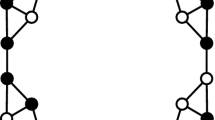Abstract
In recent years, a dynamic coloring, named as zero forcing, of the vertices in a graph have attracted many researchers. For a given G and a vertex subset S, assigning each vertex of S black and each vertex of \(V\setminus S\) no color, if one vertex \(u\in S\) has a unique neighbor v in \(V\setminus S\), then u forces v to color black. S is called a zero forcing set if S can be expanded to the entire vertex set V by repeating the above forcing process. S is regarded as a total forcing set if the subgraph G[S] satisfies \(\delta (G[S])\ge 1\). The minimum cardinality of a total forcing set in G, denoted by \(F_t(G)\), is named the total forcing number of G. For a graph G, p(G), q(G) and \(\phi (G)\) denote the number of pendant vertices, the number of vertices with degree at least 3 meanwhile having one pendant path and the cyclomatic number of G, respectively. In the paper, by means of the total forcing set of a spanning tree regarding a graph G, we verify that \(F_t(G)\le p(G)+q(G)+2\phi (G)\). Furthermore, all graphs achieving the equality are determined.

Similar content being viewed by others
Data availability
Enquiries about data availability should be directed to the authors.
References
AIM Minimum Rank C Special Graphs Work Group (2008) Zero forcing sets and the minimum rank of graphs. Linear Algeb Appl 428:1628–1648
Amos D, Caro Y, Davila R, Pepper R (2015) Upper bounds on the k-forcing number of a graph. Discret Appl Math 181:1–10
Barioli F, Barrett W, Fallat S, Hall T, Hogben L, Shader B, van den Driessche P, van der Holst H (2013) Parameters related to tree-width, zero forcing, and maximum nullity of a graph. J Graph Theory 72:146–177
Brimkov B, Hicks IV (2017) Complexity and computation of connected zero forcing. Discrete Appl Math 229:31–45
Burgarth D, Giovannetti V, Hogben L, Severini S, Young M (2015) Logic circuits from zero forcing. Nat Comput 14:485–490
Caro Y, Pepper R (2015) Dynamic approach to k-forcing, Theory Appl. Graphs 2. Article 2
Davila R (2015) Bounding the forcing number of a graph. Rice University Masters Thesis
Davila R, Henning MA (2018) Total forcing and zero forcing in claw-free cubic graphs. Graphs Combin 34:1371–1384
Davila R, Henning MA (2019) On the total forcing number of a graph. Discrete Appl Math 257:115–127
Davila R, Henning MA (2019) Total forcing versus total domination in cubic graphs. Appl Math Comput 354:385–395
Davila R, Henning MA (2020) Total forcing sets and zero forcing sets in trees. Discuss Math Graph Theory 40:733–754
Davila R, Henning MA (2020) Matching, path covers, and total forcing sets. Quaest Math 43:131–147
Davila R, Kalinowski T, Stephen S (2018) A lower bound on the zero forcing number. Discrete Appl Math 250:363–367
Davila R, Kenter F (2015) Bounds for the zero forcing number of a graph with large girth, Theory Appl. Graphs 2. Article 1
Edholm C, Hogben L, LaGrange J, Row D (2012) Vertex and edge spread of zero forcing number, maximum nullity, and minimum rank of a graph. Linear Algebra Appl 436:4352–4372
Gentner M, Rautenbanch D (2018) Some bounds on the zero forcing number of a graph. Discrete Appl Math 236:203–213
Gentner M, Penso L, Rautenbanch D, Souzab U (2016) Extremal values and bounds for the zero forcing number. Discrete Appl Math 214:196–200
Kalinowski T, Kamčev N, Sudakov B (2019) The zero forcing number of graphs. SIAM J Discrete Math 33:95–115
Lu L, Wu B, Tang Z (2012) Proof of a conjecture on the zero forcing number of a graph. Discrete Appl Math 160:1994–2005
Monshizadeh N, Zhang S, Camlibel M (2014) Zero forcing sets and controllability of dynamical systems defined on graphs. IEEE T Automat Contr 59:2562–2567
Trefois M, Delvenne JC (2015) Zero forcing sets, constrained matchings and minimum rank. Linear Algebra Appl 484:199–218
Wang X, Wong D, Zhang Y (2020) Zero forcing number of a graph in terms of the number of pendant vertices. Linear Multilinear Algebra 68:1424–1433
Zhao M, Kang L, Chang G (2006) Power domination in graphs. Discrete Math 306:1812–1816
Acknowledgements
The authors are supported by National Natural Science Foundation of China (Grant Nos. 11561032, 12301449, 12301448), supported by Shandong Provincial Natural Science Foundation (Nos. ZR2019MA012, ZR2022MA077).
Author information
Authors and Affiliations
Corresponding author
Ethics declarations
Conflict of interest
The authors declare that they have no conflict of interest.
Additional information
Publisher's Note
Springer Nature remains neutral with regard to jurisdictional claims in published maps and institutional affiliations.
Rights and permissions
Springer Nature or its licensor (e.g. a society or other partner) holds exclusive rights to this article under a publishing agreement with the author(s) or other rightsholder(s); author self-archiving of the accepted manuscript version of this article is solely governed by the terms of such publishing agreement and applicable law.
About this article
Cite this article
Ji, S., He, M., Li, G. et al. Bounding the total forcing number of graphs. J Comb Optim 46, 25 (2023). https://doi.org/10.1007/s10878-023-01089-4
Accepted:
Published:
DOI: https://doi.org/10.1007/s10878-023-01089-4




